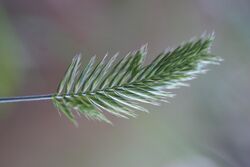Biology:Wangenheimia
| Wangenheimia | |
|---|---|

| |
| Scientific classification | |
| Kingdom: | Plantae |
| Clade: | Tracheophytes |
| Clade: | Angiosperms |
| Clade: | Monocots |
| Clade: | Commelinids |
| Order: | Poales |
| Family: | Poaceae |
| Subfamily: | Pooideae |
| Supertribe: | Poodae |
| Tribe: | Poeae |
| Subtribe: | Loliinae |
| Genus: | Wangenheimia Moench |
| Species: | W. lima
|
| Binomial name | |
| Wangenheimia lima (L.) Trin.
| |
| Synonyms[1] | |
| |
Wangenheimia is a monotypic genus of plants in the grass family. The only known species is Wangenheimia lima.[2][3]
Description
An annual ornamental grass, which bears unusual, feather-like or herringbone-shaped seedheads on long, wiry stems, all summer long.[4] It can grow up to 60 cm (24 in) tall, with long green leaves that have shades of silver when young.[5]
Taxonomy
The genus is named after the Prussian botanist Friedrich Adam Julius von Wangenheim (1749–1800).[2][6] The Latin specific epithet of lima refers to the Latin noun of file, often referring to a rough surface.[7] Wangenheimia was first described and published in Methodus on page 200 in 1794.[1] The species was first published in Fund. Agrost. on page 132 in 1820.[8]
The genus is not recognized by the United States Department of Agriculture and the Agricultural Research Service, listing it as a synonym of Festuca L. and they do not list any known species.[9]
Distribution
It is native to Spain and Portugal (in Europe) and Morocco, Algeria and Tunisia (in North Africa).[1][10][11]
It is found in grasslands,[12] at altitudes of 500 metres (1,600 ft) above sea level.[13]
Cultivation
It has been cultivated under the name Wangenheimia 'Lima Vulcan',[5] Wangenheimia lima 'Vulcan',[14] or Wangenheimia lima ‘Vulcan’ and “Vulcan Grass”.[15]
References
- ↑ Jump up to: 1.0 1.1 1.2 "Wangenheimia Moench | Plants of the World Online | Kew Science" (in en). https://powo.science.kew.org/taxon/urn:lsid:ipni.org:names:19254-1.
- ↑ Jump up to: 2.0 2.1 Moench, Conrad. 1794. Methodus Plantas Horti Botanici et Agri Marburgensis : a staminum situ describendi 200 in Latin
- ↑ Tropicos, Wangenheimia Moench
- ↑ "Wangenheimia lima" (in en). https://www.gardenersworld.com/plants/wangenheimia-lima/.
- ↑ Jump up to: 5.0 5.1 "Wangenheimia 'Lima Vulcan'". https://www.rightplants4me.co.uk/plant/3675.
- ↑ Burkhardt, Lotte (2018) (in German) (pdf). Verzeichnis eponymischer Pflanzennamen – Erweiterte Edition. Berlin: Botanic Garden and Botanical Museum, Freie Universität Berlin. doi:10.3372/epolist2018. ISBN 978-3-946292-26-5. https://doi.org/10.3372/epolist2018. Retrieved 1 January 2021.
- ↑ D. Ohrnberger The Bamboos of the World: Annotated Nomenclature and Literature of the ... (1999), p. 334, at Google Books
- ↑ "Wangenheimia lima (L.) Trin. | Plants of the World Online | Kew Science" (in en). https://powo.science.kew.org/taxon/urn:lsid:ipni.org:names:426727-1.
- ↑ "Genus Wangenheimia Moench". https://npgsweb.ars-grin.gov/gringlobal/taxon/taxonomygenus?id=12773.
- ↑ Tutin, T.G. & al. (eds.) (1980). Flora Europaea 5: 1-452. Cambridge University Press
- ↑ Dobignard, D. & Chatelain, C. (2010). Index synonymique de la flore d'Afrique du nord 1: 1-455. Éditions des conservatoire et jardin botaniques, Genève.
- ↑ Javier Loidi (Editor) The Vegetation of the Iberian Peninsula: Volume 1 (2017), p. 660, at Google Books
- ↑ Mikel Lorda López Catálogo florístico de Navarra (2013), p. 120, at Google Books
- ↑ Nico Vermeulen Summer Flowers (Rebo International, 2001), p. 308, at Google Books
- ↑ "Wangenheimia lima ‘Vulcan’ “Vulcan Grass”". https://www.anniesannuals.com/signs/v%20-%20z/wangenheima_lima.htm.
Wikidata ☰ {{{from}}} entry
 |


